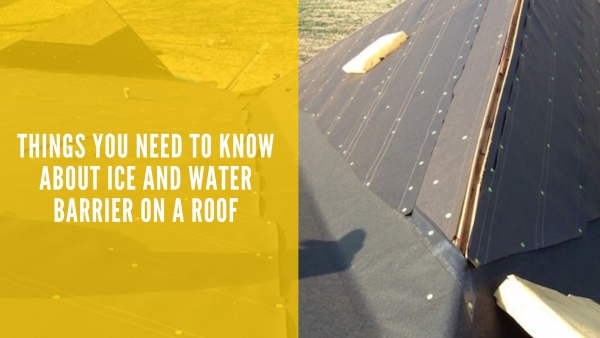
Things You Need to Know About Ice and Water Barrier on a Roof
Installing ice and water barrier on a roof is an important step to take for anyone who owns or manages a residential or commercial property. The ice and water barrier acts as the first line of defense against the formation of ice dams, icicles, and other winter weather problems.
Homeowners install an ice and water barrier on their roofs for a variety of reasons. Some want to prevent damage or leaks to their homes during the winter months, while others want to protect their roof from hail and other weather-related damage. Whatever your reasons may be, here are the things you need to know about an ice and water barrier on a roof.
What is an ice and water roof barrier?
Ice and water protector is a waterproof roof underlayment membrane developed to protect vulnerable areas of your roof from ice and water damage. It is made with polymer-modified bitumen (bitumen is commonly called asphalt), which provides excellent protection against snow, sleet, hail, rain or ice that can damage roofs.
The adhesive back surface of the membrane is perfect for areas where ice dams or severe storms are common. It sticks to the roof deck without any messy gluing, and the consistent thickness of the layer will help reduce leaks while also helping to keep your home comfortable year-round. This back surface is blanketed with a release film, which is removed during the installation process. Once the film is removed, the ice and water protector is ready to be attached to your roof. The polymer-modified bitumen will then form a watertight seal around the penetrations in the shingles, preventing ice and water from penetrating into your home.
Where is an ice and water roof barrier usually installed?
Ice and water protector is applied to eaves, rake edges, overhangs, and valleys to protect against ice dams. Apart from that, vent stacks and chimneys should be treated with ice and water protection, as they often don't overlap completely with the flashing. To keep water from penetrating the roof deck, dormers and skylights should also have ice and water protection applied.
Why do you need an ice and water barrier on your roof?
Installing an ice and water barrier on your roof will definitely add an extra layer of protection in the following parts:
- Whole roof surface: Depending on the type and frequency of extreme weather events in the area where you live, a waterproof barrier across the whole surface of your roof beneath the shingles is a great investment. This way, you can still protect your roof deck from the elements until repairs can be made even if you lose shingles during extreme weather conditions.
- Shingles: Depending on your roof's architectural design, it will have different peaks and valleys. When water trickles down from the peak, it will stock up in the valley before flowing to the gutter. This makes the valleys of your roof very vulnerable because of its frequent contact with water.
- Roof penetration: Skylights, chimneys, vents, and other vulnerable areas are all sources of water infiltration. But don't worry, placing an ice and water barrier around these areas can help seal off the gaps.
- Eaves: If there's a gap of any kind between your roof and the top of your house, the wind might get in. The wind can lift up the tips of shingles and let water in, or it can cause water backup by blocking gutters.
Types of ice and water barrier installation
Ice and water barrier installations fall into one of two categories: engineered and bare-roof.
Ice and water barrier bare-roof installations can occur on any residential roof that does not have any existing drainage on it. If you are unsure of the severity of the situation on your roof, you can call in a professional to install the ice and water barrier bare-roof for you. This is more common on newer construction, but many experienced contractors offer this type of installation.
On the other hand, engineered ice and water barrier installations are the more common type. These are installed in different ways depending on the specific purpose for which you need them.
What do you need to know before installing an ice and water barrier on your roof?
Ice and water barrier installation on a roof is easy to complete and will leave your roof looking and performing its best. Before you install any type of barrier, it’s important to make sure that your roof is strong enough to support the weight of the ice and water barrier.
For example, an ice and water barrier won’t work on a flat roof, where the weight of the snow will pull the ice and water barrier down the roof. Also, A flat-roofed house will not need an ice and water barrier to prevent water from running off the roof, since water runs off it from the gutter down to a nearby storm drain. Your roof must be very steep, with a slope of 45 degrees or more, before you install an ice and water barrier on it. Make sure that your roof is steep enough before you begin installing ice and water barriers on it.
Take an extra look around your house, property, and roof area before installing any barrier on your roof. Too, check for any visible cracks or rot.
Installing an ice and water barrier on your is just one aspect of a perfect roofing system. It is one of the most important roofing products available on the market. It's a very affordable option that also protects your roof from future damage.
If you’re planning to have an ice and water barrier installed on your roof, make Sunlight Homes your go-to professional roofing contractor. Click here to get to know more about our roofing services.
About Sunlight Homes
Located in Chatsworth in the San Fernando Valley, CA Sunlight Home Construction is committed to socially and environmentally progressive home improvements. We believe in using the best products available in the marketplace. You can contact us by calling (818) 626-8197, sending a message on our site.


